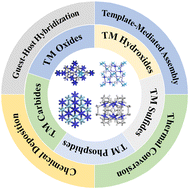Designing transition metal-based porous architectures for supercapacitor electrodes: a review
Abstract
Over the past decade, transition metal (TM)-based electrodes have shown intriguing physicochemical properties and widespread applications, especially in the field of supercapacitor energy storage owing to their diverse configurations, composition, porosity, and redox reactions. As one of the most intriguing research interests, the design of porous architectures in TM-based electrode materials has been demonstrated to facilitate ion/electron transport, modulate their electronic structure, diminish strain relaxation, and realize synergistic effects of multi-metals. Herein, the recent advances in porous TM-based electrodes are summarized, focusing on their typical synthesis strategies, including template-mediated assembly, thermal decomposition strategy, chemical deposition strategy, and host–guest hybridization strategy. Simultaneously, the corresponding conversion mechanism of each synthesis strategy are reviewed, and the merits and demerits of each strategy in building porous architectures are also discussed. Subsequently, TM-based electrode materials are categorized into TM oxides, TM hydroxides, TM sulfides, TM phosphides, TM carbides, and other TM species with a detailed review of their crystalline phase, electronic structure, and microstructure evolution to tune their electrochemical energy storage capacity. Finally, the challenges and prospects of porous TM-based electrode materials are presented to guide the future development in this field.

- This article is part of the themed collection: 2024 Reviews in RSC Advances


 Please wait while we load your content...
Please wait while we load your content...